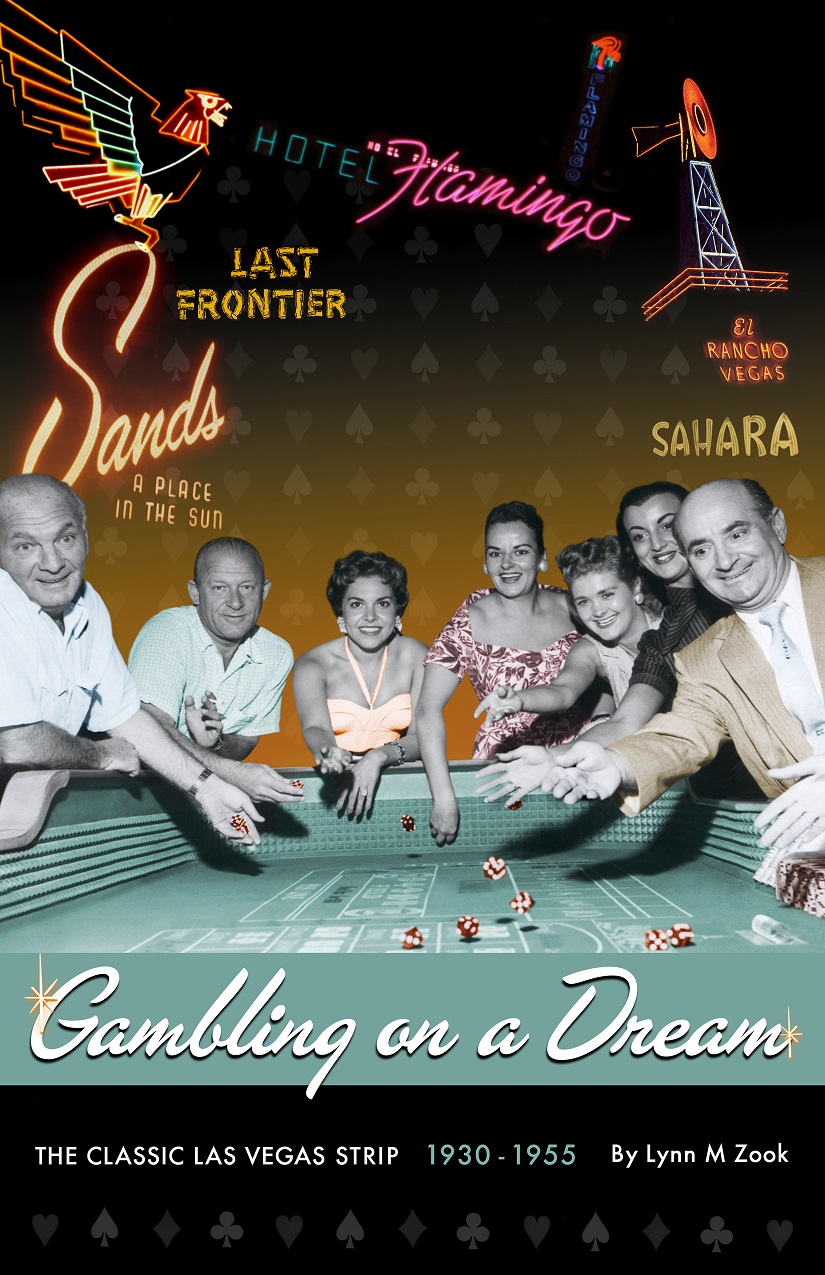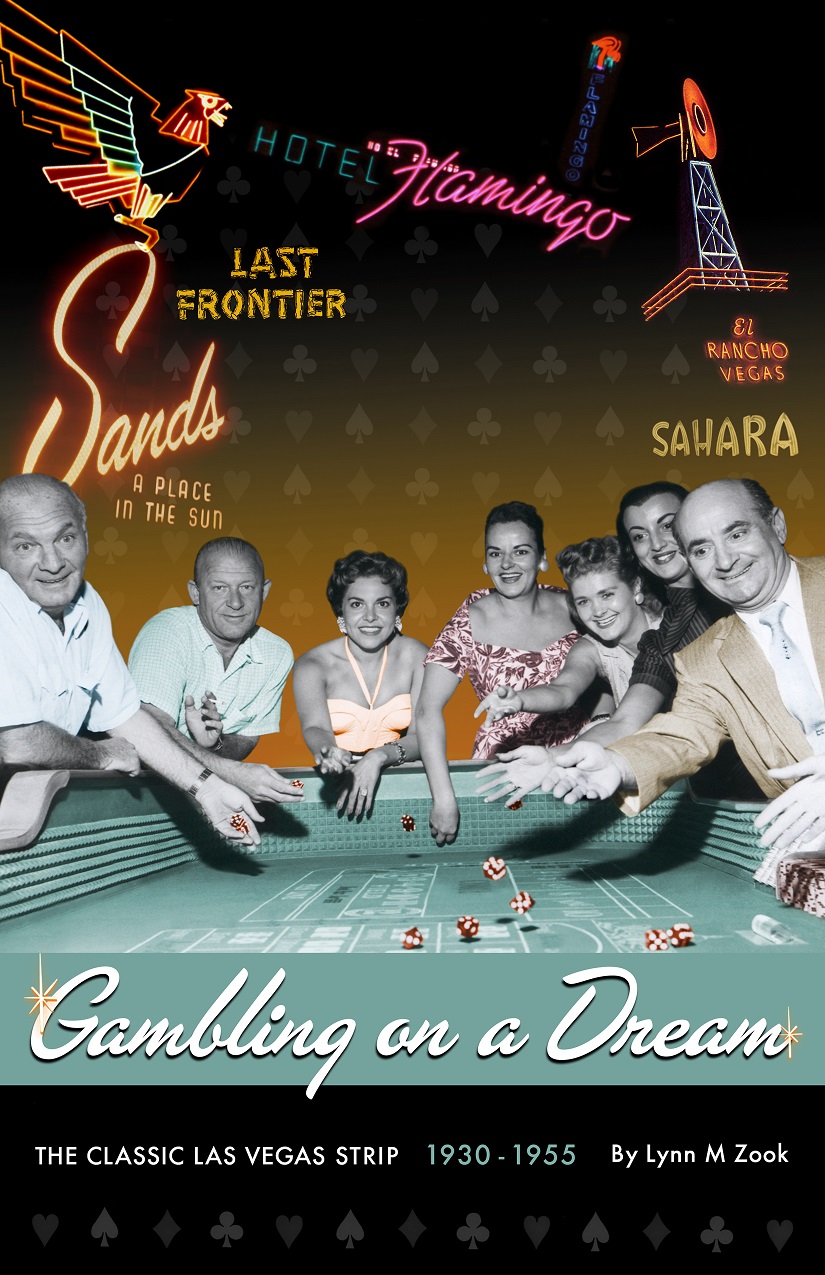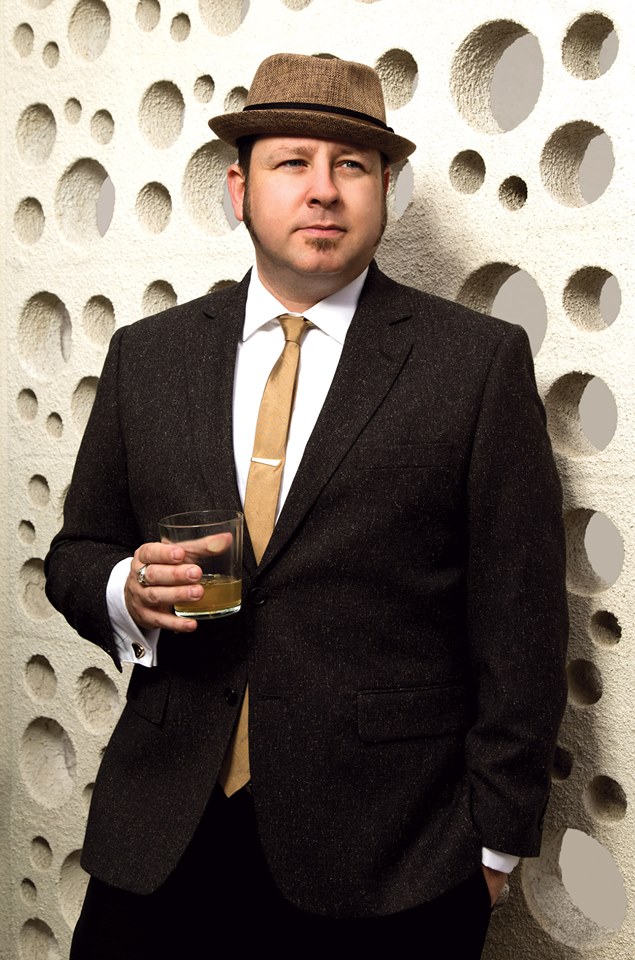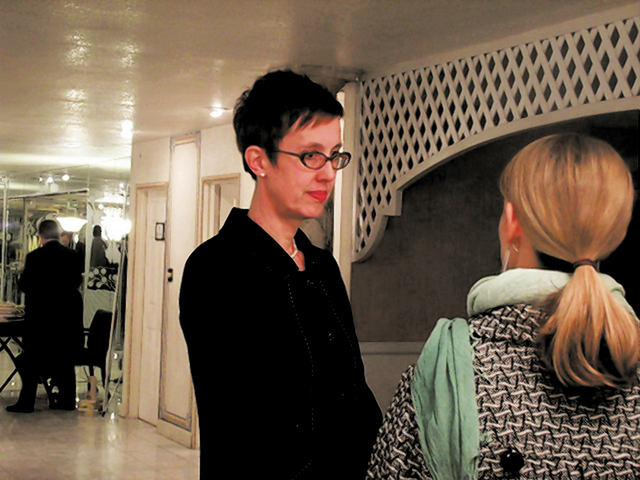Entries in Mid-Century Modern (58)
A Great Review for "Gambling on a Dream"
Writer John L. Smith wrote a dynamite review for my book, Gambling on a Dream: The Classic Las Vegas Strip 1930-1955:
It was just before Christmas in 1955 when New Orleans sax man Sam Butera received a phone call at home.
It was his old pal and occasional running mate Louis Prima on the line. Prima’s high-energy performances with Keely Smith had made them a must-see act on the Las Vegas Strip.
But the act needed to kick it up a notch. Prima was calling that Christmas Eve with a request for Butera to hop on a flight to Vegas and let that tenor sax rip.
Vegas would have to wait, but only until the day after Christmas. Butera’s decision helped define Las Vegas lounge culture forever.
It’s safe to say those of us who were fortunate enough to interview Butera never tired of hearing the generous spirit tell that story. It figures that Lynn Zook would have that anecdote – along with so many more — in her new multimedia book, “Gambling on a Dream: The Classic Las Vegas Strip 1930-1955.”
Available on Amazon, iTunes, and other sources as a download, the book includes rarely-seen photographs, interviews with Butera and many more great Las Vegas characters from the past, with nearly 40 videos. The design itself is a delight, but if you’re a lover of Las Vegas of a certain age, its the content that will make you want to jump and jive.
The book takes you through the histories of some of the most iconic hotel-casinos in the history of the Strip. They were gambling joints, sure, but between their entertainment policies and their flashy architecture the Boulevard’s best resorts dazzled hip and square alike, offering many dining experiences plus a party atmosphere 24 hours a day.
If that pitch sounds a little like the way most Las Vegas resorts portray themselves in the modern era, it’s because it’s the undeniable formula for success. Check out the clubs and pools on the Strip today – the ones with the party atmosphere are anthills of activity. Only the hairstyles and tattoos have changed.
Zook comes by her love of neon Las Vegas honestly. She moved with her family to Las Vegas on Labor Day in 1961. Her mother took a job as a showroom waitress — a great gig in that era — first in the Sky Room at the Desert Inn, then to the Sahara, and then over to the Stardust. When mom landed a coveted spot at the Circus Maximus at Caesars, it was one of the best duties on the Strip. And there were side benefits.
With a parent working in close proximity to the stage, Lynn was able to see the Smothers Brothers, “Fiddler On the Roof,” “Mame,” “Sweet Charity,” and even Elvis.
“Probably one reason why I have such a love for the town is that I had a very memorable childhood,” says Zook, a Los Angeles resident who works as a digital librarian in the consumer products division of Warner Bros. “I grew up in Las Vegas in the 1960s and 1970s in that mythical era when the city was known as the entertainment capital of the world.”
In the book, the El Rancho, Last Frontier, Flamingo, Thunderbird, and Sands are featured in fine style. And, yes, she’s already planning a followup that will highlight more resorts from the Las Vegas pantheon.
The best way to familiarize yourself with Zook’s Las Vegas love affair is to go to her classiclasvegas.com site, where you’ll be reminded that her devotion is “part of a nearly two-decade long historical preservation project documenting the history of Las Vegas and the stories of the men and women who transformed it from a dusty railroad town into one of the most legendary cities ever built.” Her blog posts are fascinating.
She left Las Vegas in 1977 to attend college in California, but “over the years, going back and forth visiting family I realized the city was changing rapidly and the town I’d grown up with was vanishing from the landscape.
“I wanted to help preserve sort of as many of the stories as I could.
Like Butera and Prima and all the other finger-snapping inhabitants of her new book, Lynn Zook doesn’t miss a beat.
If you still haven't read my book, you can learn more about it at my website Classiclasvegas.com
It's just $4.99!
Special thanks to CDC Gaming Reports: http://www.cdcgamingreports.com/commentaries/a-valentine-to-vegas-past-lynn-zooks-new-book-makes-strip-sparkle-with-nostalgia/

Gambling on a Dream makes a great holiday gift!
As you begin your holiday shopping, please don't forget-Gambling on a Dream: The Classic Las Vegas Strip 1930-1955.
If you love or know someone who also loves Las Vegas history, the Las Vegas Strip and/or the hotels that used to be there, this book makes a perfect gift.
Everyone thinks they know the history of the Las Vegas Strip but the real story is one that many people will be surprised to learn that they know only parts of the story. Want to know what was there before the Bellagio, the Wynn and the Encore, the SLS, the Venetian, or those empty plots of land that look out of place? Why is the Flamingo one of the oldest and most surviving hotels on the boulevard?
A detailed history of each the first ten hotels on the famed boulevard-from conception to what happened to them, this book also has rarely seen images and video clips featuring the men and women who worked there, played there and helped make Las Vegas the Entertainment Capital of the World.
Read the detailed histories of the first ten hotels on the Las Vegas Strip, including the El Rancho Vegas, Hotel Last Frontier, Flamingo, Thunderbird, Wilbur Clark's Desert Inn, Sahara, Sands, Royal Nevada, Riviera and the Dunes. Included in these histories are the architectural designs, the neon signage and how each of the hotels evolved.
The dreamers, who saw the future like few others and who built these hotels, helped turn a five-mile stretch of blacktop highway into the Entertainment Capital of the World.
This is the story of the first twenty-five years of the Classic Las Vegas Strip-how it began, and how it grew.
Just $4.99.
Available for Mac laptops and iPad users on the iTunes Store, for Kindle and Fire Tablets it's available on Amazon and for Nook readers, it is available on NookPress.
For direct links to the Itunes store, Amazon and NookPress, go here.

Preservation Spotlight: Clay Heximer, neighborhood preservationist

You may know Clay Heximer. He recently was profiled by writer Geoff Carter in Vegas Seven as "The Man Who Would Be Mid-Town"
But many of us have known Clay for quite some time. He and his wife Denise live in Paradise Palms, the wonderful Mid-Century Modern housing tract that surrounds the National Golf Course, just off Desert Inn behind the Boulevard Mall.
When I was growing up in Las Vegas in the 1960s, the National Golf Course was then known as the Stardust Golf Course. But it wasn't the golf course that caught my eye. It was the houses, most of which were visible from the car as you drove down East Desert Inn.
Those wonderful Palmer and Krisel were space age wonders and very different from the Sproul homes in my own neighborhood in Charleston Heights.
Clay and Denise live in Paradise Palms and their successful community outreach and history sharing has inspired many of their neighbors to learn more about their homes and the history of the neighborhood.
Clay started a website dedicated to the neighborhood, called appropriately enough, Paradise Palms and, like Joel Rosales, has been photographing the changing landscape of the city and the county.
Clay has been organizing and fighting to bring Historic Preservation ordinances to Clark County and he has been successful in convincing others to join his cause.
As we close Preservation Month and the Preservation Spotlight series winds down, it was important to me to include a grass-roots leader of history and preservation in the series.
Clay graciously agreed to answer some questions and spread the word about the importance of our neighborhoods, all of our historic neighborhoods.
CLV Blog: How did you become interested in preserving Southern Nevada history?
Heximer: Before moving to town I remember taking a family trip to Las Vegas. I recall sitting in the back of my uncle’s station wagon, driving down the strip. I was in awe of all the neon but I specifically thought the Stardust sign was the coolest thing ever. Since then, I just knew there was something special about this place and had gained an appreciation for classic Vegas.
When I was 19, I worked with a construction company that was contracted the prep the Dunes for implosion. I remember being taken back by the celebration of the destruction of our history and was shocked by the disregard for
Read more at ClassicLasVegasBlog.com
Preservation Spotlight: Heidi Swank, preservationist

I first met Heidi about eight years ago when we were both involved in the early days of the Atomic Age Alliance, an organization dedicated to Mid-Century Modern Las Vegas. She and her husband were both passionate about Mid-Century Modern architecture and wanted to learn more about Las Vegas' role in that history.
She and her husband, Scott, have a MCM home in the historic Beverly Green neighborhood that they have lovingly restored. They live in a 1956 Cinderella ranch designed by Hugh Taylor for Rose and Louis Molasky the parents of Irwin Molasky. They co-founded the popular Flamingo Club- a roving, invitation-only neighborhood mixer whose motto is “Building community one cocktail party at a time."
She is dedicated to the worthy idea that our classic homes are worth saving. While Las Vegas experienced tremendous growth in the final decades of the 20th century and early 21st century, its original neighborhoods offer a look back at not only how the city grew but through its architecture offers insight to those years before the explosion boom and what was important to the residents who owned those homes.

Beverly Green neighborhood Photo courtesy of Las Vegas CityLife
In addition to be elected to the Nevada State Assembly for District 16, she is also the Exective Director of the Nevada Preservation Foundation.
The NPF is a "non-profit that provides historic designation and grant support to neighborhoods, homeowners, and business owners who reside in a historic area or own a historic building. The Foundation supplies much needed support to navigate the extensive process of obtaining local, state, or federal historic designations. Once designated the Foundation also provides grant-writing support and functions as a clearinghouse for grants benefiting historic districts/homes. As more of our state’s architectural past ages into eligibility for historic designation, it is important for the stability of our communities that we work to maintain our history."
Despite her very busy schedule, we were able to interview her for this series.
CLV Blog: How did you become interested in preserving Southern Nevada history?
Swank: As an anthropologist by training, I have long been interested in the ways in which our past makes us who we are today. In particular, I'm interested in how our built environment and the ways in which space is used in these homes reflects and impacts how we see them, how we use them, and how we understand ourselves.
One of the more interesting things about Southern Nevada history is that there isn't a lot of time depth. Many people discount the area because of this saying we don't have any history. However, because our history is relatively new it is in many ways more interesting.
We don't have hundreds of years of
Read more at ClassicLasVegasBlog.com
Preservation Spotlight: Joel Rosales, photographer

Today we shine our Preservation Spotlight on Joel Rosales. While you may not know Joel's name, chances are you are familiar with his photographs. For over ten years now, Joel has been documenting the changing landscape of Las Vegas and the surrounding Valley. From hotel demolitions to neon signage to historic neighborhoods, Joel has been photographing it.
Another native son, Joel has a keen interest in our history and our past. Through his original website, LeavingLV.net and now LostandFoundVegas.com, Joel has been sharing his photographs, memorabilia and photo collections with the world.
I met Joel back around 2005-2006 when I began hosting panel discussions at the Nevada State Museum and have been a big fan of his work ever since. His dedication to documenting our history often means he is up before dawn heading to yet another location that will become a place that isn't there anymore but will live on in his photographs.
Joel was more than happy to answer a few questions and share his thoughts on the City, its history and his passion for preserving it.
CLV Blog: How did you become interested in Las Vegas history?
Rosales: Having been born and raised here I never really understood what Las Vegas really was to the world. As I watched movies and read books that are much older than I am, I began to realize what a unique and storied history we have right here in my very own home town and began seeking out the places I'd seen and read about. When the realization came that most of these places are long gone, I began delve much deeper into their stories and made myself
Read more of the interview at ClassicLasVegasBlog.com



